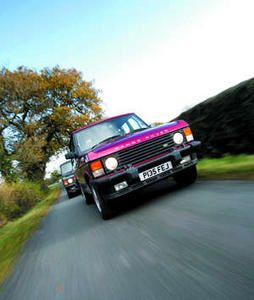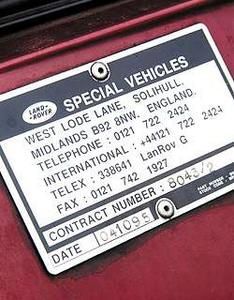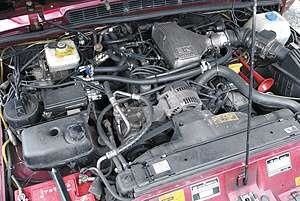Hier ein kleiner Artikel über die vermeintl letzen Range Rover Classic von dr Antiterroreinheit 12SAS22:
The professionals
from the earliest days of Range Rover production, the vehicle was selected as a supreme off-roader by Britain’s special forces
‘D Squadron were on the Anti-Terrorist Team. This was lucky because I was looking forward to getting out of the ‘green’ kit and learning a different soldiering skill. As I walked to the Squadron office I could see a building with several garage doors. This must be the place, I thought. The doors were open, it was a hive of activity, blokes running all around the place. Weapons of all descriptions were out on pallets, and equipment I had never seen before was stacked up along the walls. A Range Rover was in every hangar doorway.’
Nigel ‘Spud’ Ely, For Queen and Country
On September 5, 1972, the world watched helplessly as a Palestinian terrorist group massacred Israeli athletes taken hostage in a raid on the competitors’ accommodation at the Munich Olympics. West German police sharpshooters had tried to kill the terrorists in an attempt to prevent them leaving the country with their nine captives, but a lack of training and experience saw the operation turn into a fiasco.
Within days, British Prime Minister Edward Heath and his cabinet had authorised the formation of a specialist army unit to counter any future similar outrage in the UK, and the job was turned over to 22 Regiment of the Special Air Service (22 SAS). This unconventional military formation had already been operating a small ‘Counter Revolutionary Warfare’ cell for a number of years, but the new terrorist situation now allowed them access to all the funding they needed to get the job done. One of their first purchases would be a small fleet of Range Rovers.
Of all the military Land Rover vehicles and variants that I have covered over the last two decades, the SAS Range Rovers have been the most difficult to find accurate information about. The Ministry of Defence has a strict policy of not discussing our Special Forces, of which 22 SAS is just one of a number, and it will neither confirm nor deny just about every question asked on the subject. It also hammers home this message to the many companies which officially supply specialist equipment to these clandestine units, with the result that they too refuse to answer questions point blank, even when the evidence is staring everyone in the face.
snippets of information
As a rule of thumb, whenever I am told by a military sales rep that “our product is used by the SAS”, I take his comments with a shovel of salt, as those who do supply seldom speak about it. However, in a democracy no organisation can maintain complete secrecy, and odd little snippets of information are bound to leak out. Anything you read in this article is based on personal observation or on published facts and photographs, corroborated by conversations on the subject with a number of high profile former SAS troopers and non-commissioned officer authors, who it has been my pleasure to interview over the last five years or so.
The best source of original information on the SAS Range Rovers is former SAS Sergeant Barry Davies who, along with Major Alistair Morrison, helped Germany’s new GSG-9 anti-terrorist unit with the successful operation to free terrorist captives held on a hijacked aircraft at Mogadishu in 1977. In his book Complete Encyclopedia of the SAS Barry says that when the anti-terrorist teams were formed in November 1972: “The government sanctioned the purchase of six Range Rovers, and a team of SAS soldiers was sent to the factory to collect them directly from the assembly line”. At this time, the Range Rover had been in production for under two years, but it had already established a reputation for being the best vehicle for combined on-road and off-road use.
ladder chassis
In most anticipated scenarios the CRW assault teams would need to travel quickly by road to near the scene of an incident, and once there possibly traverse rough or difficult terrain. So the, then new, Range Rover with its powerful V8 engine was simply the only vehicle for the job. As a bonus, because it had a traditional ladder chassis like the Land Rover, it could also be easily lashed down for transportation inside the C-130 Hercules and flown anywhere in the world.
These first six Range Rovers were standard specification two-door vehicles. Although relatively ostentatious, as few of the public were aware of the nature of the SAS in those days, their use did not attract undue attention. However, the London Iranian Embassy siege of 1980 would see Britain’s men in black come to worldwide prominence as they successfully rescued more than twenty hostages and killed five out of six terrorists, under the gaze of television news cameras transmitting live around the globe.
Range Rovers were used to transport the initial response teams, which were literally on standby to move within minutes of an alert, from the regiment’s former headquarters in Hereford to the London incident scene.
In the mid-eighties, the four-door Range Rover was taken on-strength by the regiment, and around about the same time a demountable assault platform and ladder system was added. In a personal photographic collection that I have seen, earlier two-door vehicles can be seen during an aircraft assault training exercise. In this instance, SAS troopers in full riot gear are sitting on the tailgate, carrying loose aluminium ladders to access the fuselage. This method was both basic and time-wasting, so the idea of mounting aluminium bonnet and roof platforms, to which ladders could be securely attached, was conceived.
Later versions of these platforms, which are now used by police and military counter-terrorist teams around the world, would incorporate running boards for personnel to hang onto the sides during fast assaults, banks of ladders to allow aircraft escape doors, low roofs or first floor balconies to be assaulted directly and collapsible guard rails to allow operatives to stand upright atop vehicles moving at high speed. Barry Davies published the best genuine photographs (beware that many other pictures are reconstructions) of Range Rovers with assault platforms fitted in his 1996 book SAS, The Illustrated History. One of these photos, dated 1992, is of a group photo of nineteen personnel sitting on and standing between a pair of black or very dark blue E-registration Range Rovers.
roll cages
Many published sources mention that the SAS Range Rovers were fitted with roll cages. Clearly, as the first vehicles were taken straight from the Solihull production line, they would not have had them fitted as standard, but later batches of vehicles certainly were equipped with internal cages from new. However, these were so discreetly fitted that it is difficult to spot them on photographs, and indeed one writer on this topic in another Land Rover magazine seems not to have even noticed the cage when driving one of them, as he makes no comment whatsoever on this subject. To those who knew what they were looking for, it is the internal roll cage and the bumper mounts for the assault platform, plus occasionally the fitting of discrete extra communications antennae, that gave away the owners of otherwise standard appearance Range Rovers.
As far as can be determined, the last Range Rovers were ordered by the SAS just prior to completion of production of the original shape vehicle. Shortly after this, another road-biased Land Rover variant was officially taken on-strength by the SAS. The reason why this batch of very late model Classics was procured instead of new-shape vehicles is entirely logical. The new P38A was primarily a high specification executive transport, and a pair of these out and about carrying four denim-clad, desert boot shod, moustachioed troopers apiece would have attracted the media spotlight like moths to a candle.
There is probably no way of knowing just how many Range Rovers have been used by the SAS over the past three decades – almost every one of them has been quietly and cautiously disposed of due to the sensitivity of their role. In the late eighties I saw a couple of the two-door versions leading another life in a vehicle depot not too far from the British mainland, and it is possible that others followed this route when their time was up with the Counter Revolutionary Warfare teams, but details of this may not come out in the foreseeable future. However, with the other vehicle model having superseded the Range Rover in the mid-nineties, what we assume to be the final batch of SAS Classics was released for public auction around March 2001. A small number of slightly earlier classics had been sold off prior to this, but the batch of four which came out at BCA Newport has the latest chassis numbers of which LRM is aware.
anonymous-looking
Classified by the military as Car Utility 4x4 3.9 Litre V8 Petrol Range Rover, the four vehicles bearing the call-signs TAC71 to TAC74 carried military registration numbers in the batch EV70AA to EV73AA, though not in any particular order, and had chassis numbers in the MA662### series. They also had random anonymous-looking civilian number plates, which they would have carried while in the UK. Body colours varied and were standard shades, though not ones current for the Classic series at time of manufacture. Two were blue, one was green and the fourth was red – the latter being Rioja Red Micatallic, to be precise. It is known that Land Rover’s Special Vehicles department did the conversion work. From the release paperwork, we know that the vehicles entered service in early January 1996 and were cast, which is the military term for taken off active service, in late March 2001, having clocked up annual mileages averaging around 10-12,000.
slightly deformed
Other than the two receiving sockets on the bumper, which would have held the support legs for the section of demountable assault platform over the bonnet, there is little external sign that these Range Rovers are anything other than civilian vehicles. The keen eye will spot that the roof gutters are deformed at the points where the roof section of the assault platform was supported, but such deformation could easily have been done by any heavy roof rack. The door panels are also slightly deformed where the struts for the lower ladders would have come in contact. As previously mentioned, the Safety Devices roll cage is sufficiently discreet as to pass almost unnoticed, and the load compartment safety guard can pass for a dog grille.
Less noticeable changes included Southdown steering and axle guards for underside protection and a run-flat tyre system fitted to Discovery wheels. Though disconnected before disposal, the headlights had a police-style occulting switch unit and 120 decibel two-tone horns were fitted. Switches for infrared lights were also fitted, though the lights themselves were removed, and the vehicles also carried twin batteries with a split charging system. One other minor, but very necessary extra, was the stalk-mounted map light for the front passenger. Finally, a heavy duty tow pack and up-rated anti-roll bars were supplied.
With the help of Dave Wilson (EV71AA), who owns the red right hand drive vehicle, we tracked down second owner Ian Birchall (EV70AA), of Tearles Jungle Garage near Preston, and brought two of the four together again for a few hours. At the time a third vehicle (EV72AA) from the batch was being offered for sale by a Hereford garage. We have temporarily lost track of the fourth, but hopefully somebody reading this will be able to put us in touch with the present owner.
impressive
Finally, the question you have all been asking – what has been done to these Range Rovers on the performance side? To be frank, we don’t actually know, and to say otherwise would be silly. Even now, nearly two years after release, the engines are remarkably powerful, and they have very evidently been doctored. Dave has added an LPG conversion to his, and in this mode the vehicle is no slouch, but when run on petrol it almost takes off. As Nick is the Rangey expert, having written his first book on the topic when only thirteen and owned a left-hand-drive two-door Range Rover as soon as he was old enough to get it insured, I let him take to the wheel. “Impressive”, was his understated comment as the keys were prised out of his clenched fist at the end of the day.
Unfortunately, the guidelines on reporting Special Forces activities laid down by the Defence Advisory Committee prevent us delving much further into the secretive world in which these vehicles performed. However, it is now no great secret that Britain’s military elite quickly appreciated the benefits of the Range Rover right from the outset, but what is so surprising is that they stayed loyal to the same model for nearly thirty years when they, of all people, had the funding and political clout to procure any vehicle they wanted or needed.



 Sie sind vermutlich noch nicht im Forum angemeldet - Klicken Sie hier um sich kostenlos anzumelden
Sie sind vermutlich noch nicht im Forum angemeldet - Klicken Sie hier um sich kostenlos anzumelden